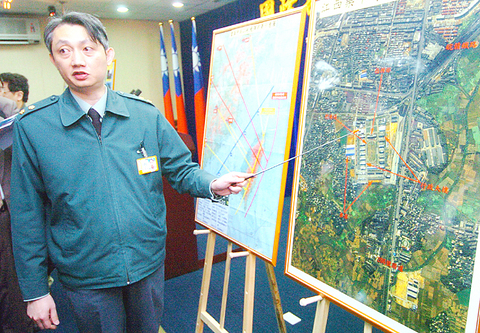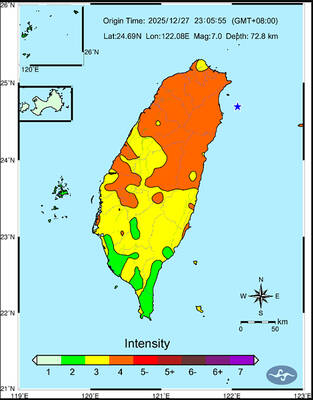The Ministry of National Defense (MND) said yesterday that China now has more than 800 missiles targeting Taiwan, and is increasing that arsenal at a faster pace of 75 to 100 per year.
The news came as Beijing defended its recent announcement of another double-digit increase -- 14.7 percent -- in this year's military budget.
"China was producing around 50 Dong Feng [DF] series ballistic missiles annually, but ... our intelligence has found it is now increasing by 75 to 100 ballistic missiles annually," said Lieutentant Colonel Chen Chang-hwa (

PHOTO: CHEN TSE-MING, TAIPEI TIMES
Chen said if cruise missiles are included, China now has more than 800 missiles aimed at Taiwan, enabling Beijing to potentially launch a five-wave missile attack continuing for 10 hours.
The PLA's ballistic missiles are now also more precise, according to Chen. They used to have a 600m margin of error, but that has been reduced to 50m, giving China the capability to more accurately hit Taiwan's power stations, radar bases, airstrips and military, economic and political nerve centers.
China's main ballistic missiles are DF-11 missiles that have a range of 600km, and DF-15 missiles that have a range of 800km, Chen added.
Chen said the PLA deploys its ballistic missiles in five bases in southeast China, at Leping and Kanzhou cities in Jiangxi Province, Meizhou City in Guangdong Province and Yongan and Xianyou cities in Fujian Province.
"The missiles can be transported by rail at any time to [China's] coastal areas," Chen added.
The MND also revealed details about the 1996 cross-strait missile crisis on the eve of the event's 10th anniversary.
On March 8, 1996, ahead of Taiwan's first presidential election, China fired ballistic missiles into the sea near Taiwan.
MND spokesman Rear Admiral Liu Chih-chien (
From July 21 to July 24, 1995, the PLA launched six DF-15 missiles from Jiangxi Province's Qianshan City, which traveled 481km before dropping into the sea 130km north of Taiwan, Liu said.
From March 8 to March 13, 1996, the PLA launched one DF-15 missile from Fujian Province's Nanping City, which traveled 500km and landed just 37km from Taiwan.
It also launched three DF-15 missiles from Yongan City that flew 460km before landing 55.5km from Kaohsiung City, Liu said.
"The two missile exercises proved that China's DF-series ballistic missiles, which have better accuracy, are able to effectively attack Taiwan's critical facilities and blockade the island," Liu said.
Liu said that while the 1995 missile drill was intended to bully Taiwan after former president Lee Teng-hui's (李登輝) visit to the US, the 1996 drill was an attempt to influence that year's presidential election.
The ministry had said that the missile exercises had a profound influence on the country's defense preparations.
The military started to develop anti-missile warfare capabilities after the drills, and began developing the nation's own strategic missiles to deter China.

A magnitude 7.0 earthquake struck off Yilan at 11:05pm yesterday, the Central Weather Administration (CWA) said. The epicenter was located at sea, about 32.3km east of Yilan County Hall, at a depth of 72.8km, CWA data showed There were no immediate reports of damage. The intensity of the quake, which gauges the actual effect of a seismic event, measured 4 in Yilan County area on Taiwan’s seven-tier intensity scale, the data showed. It measured 4 in other parts of eastern, northern and central Taiwan as well as Tainan, and 3 in Kaohsiung and Pingtung County, and 2 in Lienchiang and Penghu counties and 1

FOREIGN INTERFERENCE: Beijing would likely intensify public opinion warfare in next year’s local elections to prevent Lai from getting re-elected, the ‘Yomiuri Shimbun’ said Internal documents from a Chinese artificial intelligence (AI) company indicated that China has been using the technology to intervene in foreign elections, including propaganda targeting Taiwan’s local elections next year and presidential elections in 2028, a Japanese newspaper reported yesterday. The Institute of National Security of Vanderbilt University obtained nearly 400 pages of documents from GoLaxy, a company with ties to the Chinese government, and found evidence that it had apparently deployed sophisticated, AI-driven propaganda campaigns in Hong Kong and Taiwan to shape public opinion, the Yomiuri Shimbun reported. GoLaxy provides insights, situation analysis and public opinion-shaping technology by conducting network surveillance

Taiwan is gearing up to celebrate the New Year at events across the country, headlined by the annual countdown and Taipei 101 fireworks display at midnight. Many of the events are to be livesteamed online. See below for lineups and links: Taipei Taipei’s New Year’s Party 2026 is to begin at 7pm and run until 1am, with the theme “Sailing to the Future.” South Korean girl group KARA is headlining the concert at Taipei City Hall Plaza, with additional performances by Amber An (安心亞), Nick Chou (周湯豪), hip-hop trio Nine One One (玖壹壹), Bii (畢書盡), girl group Genblue (幻藍小熊) and more. The festivities are to

AFTERMATH: The Taipei City Government said it received 39 minor incident reports including gas leaks, water leaks and outages, and a damaged traffic signal A magnitude 7.0 earthquake struck off Taiwan’s northeastern coast late on Saturday, producing only two major aftershocks as of yesterday noon, the Central Weather Administration (CWA) said. The limited aftershocks contrast with last year’s major earthquake in Hualien County, as Saturday’s earthquake occurred at a greater depth in a subduction zone. Saturday’s earthquake struck at 11:05pm, with its hypocenter about 32.3km east of Yilan County Hall, at a depth of 72.8km. Shaking was felt in 17 administrative regions north of Tainan and in eastern Taiwan, reaching intensity level 4 on Taiwan’s seven-tier seismic scale, the CWA said. In Hualien, the